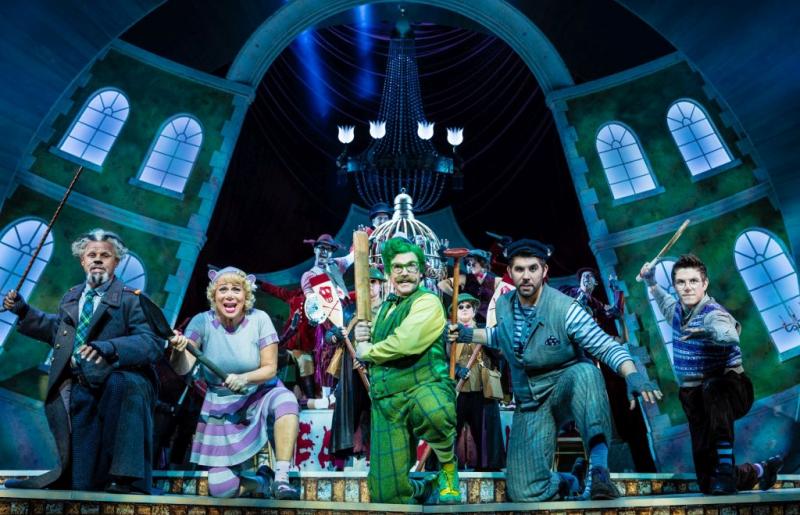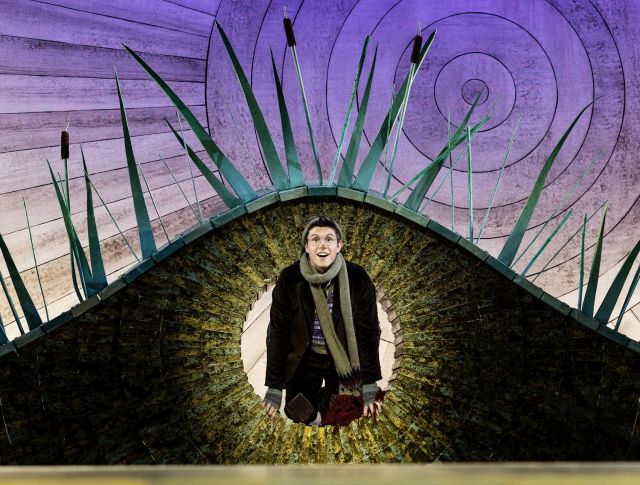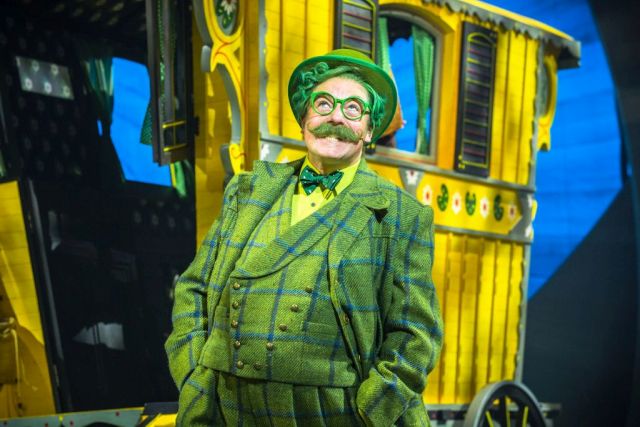The Wind in the Willows, London Palladium review - an effortful slog | reviews, news & interviews
The Wind in the Willows, London Palladium review - an effortful slog
The Wind in the Willows, London Palladium review - an effortful slog
Kenneth Grahame-inspired musical starring Rufus Hound is at once overly perky and dramatically weightless

An enormous amount rides on a musical's opening number. Without explicitly expressing it, a good opener sets tone, mood and style. Take The Lion King, where "Circle of Life" so thrillingly unites music, design and direction that nothing that follows equals it. "Spring", the opener of The Wind in the Willows, repeatedly announces the warmth of the season, and precious little else.
There's a (tiny) moment of jeopardy in the first act, where, in an unexpected burst of stage business, Craig Mather's Mole (pictured below) opens a picnic basket and runs about trying to catch belongings thrown to him by Simon Lipkin's Rat. It's remarkable because it's just about the only moment of tension and release throughout a first half that lasts 70 minutes or so, but feels much longer. This is unquestionably the fault of book writer Julian Fellowes, whose adaptation makes Downton Abbey seem like The Cherry Orchard.
Kenneth Grahame's beloved children's classic is not an easy prospect for adaptation. The gently told riverbank tale of friendship between sensible Rat and naive Mole, wise Badger and devil-may-care Toad, was long ago turned into theatrical favourite Toad of Toad Hall, but even that was high on atmosphere and strikingly low on plot. That difficulty notwithstanding, there is simply no excuse for writing as lazy as this.
 Fellowes merely brings characters on, saddles them with exposition concerning themselves and their situations, hands them a line of plot, steps aside for a song, and moves on. As a result, almost all his characters swap convincing detail for a regional accent ranging from hedgehogs from Birmingham to Mole's all-purpose yokel. Energetic Rufus Hound manages not to overplay Toad's bumptiousness but even with his restraint, it's hard to fathom why the characters are friends. (Hound pictured below by Marc Brenner)
Fellowes merely brings characters on, saddles them with exposition concerning themselves and their situations, hands them a line of plot, steps aside for a song, and moves on. As a result, almost all his characters swap convincing detail for a regional accent ranging from hedgehogs from Birmingham to Mole's all-purpose yokel. Energetic Rufus Hound manages not to overplay Toad's bumptiousness but even with his restraint, it's hard to fathom why the characters are friends. (Hound pictured below by Marc Brenner)
It's one "and then..." scene after another, all with the same dramatic weightlessness. To rebalance the all-male original, Fellowes adds a no-nonsense Geordie, Mrs Otter (Denise Welch), and her daughter, Portia (Emilie du Leslay). The latter's abruptly stated longing for the dangerous wild wood leads to the kidnapping that drives what passes for a plot. But as with the teenagers in the equally lamentably underwritten (and soon to close) musical The Girls, their characters are so flimsily one-note that it's impossible to care about them. Nor does it help that Fellowes writes subtext-free dialogue that has to be delivered in over-bright, effortful, children's TV-presenter voices. Has no one seen War Horse or The Curious Incident of the Dog in the Night-Time?
 George Stiles's music and Anthony Drewe's lyrics aim to supply the charm so egregiously missing elsewhere, and in a bouncy number like "The Open Road", as the friends set off in a beautiful gypsy caravan drawn by a sweetly tap-dancing horse (Natalie Woods), they succeed. Stiles writes in the programme about wanting "to draw on all the things we love about the last 150 years of British music". Thus, we have shades of Gilbert & Sullivan and Flanders & Swann via Vaughan Williams and even a touch of glam rock for the wicked weasels. But the songwriters hoist themselves by their own petard: beyond Stiles's bursts of uplifting choral harmonies, their songs lack personality. Even the would-be touching song about friendship is sung loudly in order to achieve anthemic uplift. Would it have killed anyone to have a moment of quiet and genuine tenderness?
George Stiles's music and Anthony Drewe's lyrics aim to supply the charm so egregiously missing elsewhere, and in a bouncy number like "The Open Road", as the friends set off in a beautiful gypsy caravan drawn by a sweetly tap-dancing horse (Natalie Woods), they succeed. Stiles writes in the programme about wanting "to draw on all the things we love about the last 150 years of British music". Thus, we have shades of Gilbert & Sullivan and Flanders & Swann via Vaughan Williams and even a touch of glam rock for the wicked weasels. But the songwriters hoist themselves by their own petard: beyond Stiles's bursts of uplifting choral harmonies, their songs lack personality. Even the would-be touching song about friendship is sung loudly in order to achieve anthemic uplift. Would it have killed anyone to have a moment of quiet and genuine tenderness?
Matters aren't helped by Aletta Collins's choreography, which individualises animals but fails to heat up either the space or the audience. Her moves are illustrative rather than dynamic, so that her numbers never build. Instead of acknowledging real excitement, audiences applaud the dancers' efforts, thanks in no small part to lighting designer Howard Harrison. He and director Rachel Kavanaugh and orchestrators Christopher Jahnke and David Shrubsole work hard to put a button on every number – that's to say, a combined snap lighting change and orchestral "sting" on the end of a song to win applause.
Elsewhere, Harrison deploys saturated colours to create the tonal contrast the writing lacks. He's an ideal support for designer Peter McKintosh, whose wood-toned sets are the unquestionable star of this large, costly show. In a theatre with perilously little depth or wing space, he works wonders creating weeping willow branches, riverside homes, car crashes and the towering emerald green spectacle of Toad Hall.
You needn't have heard the still-available recording of Alan Bennett reading Grahame's original, or be old enough to remember Nicholas Hytner's heartstopping, nostalgia-tinged National Theatre production of Bennett's suggestive adaptation (from 1990), to appreciate how depressingly brash this is. Running the gamut from jolly to jocular, it never entertains the risk of real emotion.
The future of Arts Journalism
You can stop theartsdesk.com closing!
We urgently need financing to survive. Our fundraising drive has thus far raised £49,000 but we need to reach £100,000 or we will be forced to close. Please contribute here: https://gofund.me/c3f6033d
And if you can forward this information to anyone who might assist, we’d be grateful.

Subscribe to theartsdesk.com
Thank you for continuing to read our work on theartsdesk.com. For unlimited access to every article in its entirety, including our archive of more than 15,000 pieces, we're asking for £5 per month or £40 per year. We feel it's a very good deal, and hope you do too.
To take a subscription now simply click here.
And if you're looking for that extra gift for a friend or family member, why not treat them to a theartsdesk.com gift subscription?
more Theatre
 Othello, Theatre Royal, Haymarket review - a surprising mix of stateliness and ironic humour
David Harewood and Toby Jones at odds
Othello, Theatre Royal, Haymarket review - a surprising mix of stateliness and ironic humour
David Harewood and Toby Jones at odds
 Macbeth, RSC, Stratford review - Glaswegian gangs and ghoulies prove gripping
Sam Heughan's Macbeth cannot quite find a home in a mobster pub
Macbeth, RSC, Stratford review - Glaswegian gangs and ghoulies prove gripping
Sam Heughan's Macbeth cannot quite find a home in a mobster pub
 The Line of Beauty, Almeida Theatre review - the 80s revisited in theatrically ravishing form
Alan Hollinghurst novel is cunningly filleted, very finely acted
The Line of Beauty, Almeida Theatre review - the 80s revisited in theatrically ravishing form
Alan Hollinghurst novel is cunningly filleted, very finely acted
 Wendy & Peter Pan, Barbican Theatre review - mixed bag of panto and comic play, turned up to 11
The RSC adaptation is aimed at children, though all will thrill to its spectacle
Wendy & Peter Pan, Barbican Theatre review - mixed bag of panto and comic play, turned up to 11
The RSC adaptation is aimed at children, though all will thrill to its spectacle
 Hedda, Orange Tree Theatre review - a monument reimagined, perhaps even improved
Scandinavian masterpiece transplanted into a London reeling from the ravages of war
Hedda, Orange Tree Theatre review - a monument reimagined, perhaps even improved
Scandinavian masterpiece transplanted into a London reeling from the ravages of war
 The Assembled Parties, Hampstead review - a rarity, a well-made play delivered straight
Witty but poignant tribute to the strength of family ties as all around disintegrates
The Assembled Parties, Hampstead review - a rarity, a well-made play delivered straight
Witty but poignant tribute to the strength of family ties as all around disintegrates
 Mary Page Marlowe, Old Vic review - a starry portrait of a splintered life
Tracy Letts's Off Broadway play makes a shimmeringly powerful London debut
Mary Page Marlowe, Old Vic review - a starry portrait of a splintered life
Tracy Letts's Off Broadway play makes a shimmeringly powerful London debut
 Little Brother, Soho Theatre review - light, bright but emotionally true
This Verity Bargate Award-winning dramedy is entertaining as well as thought provoking
Little Brother, Soho Theatre review - light, bright but emotionally true
This Verity Bargate Award-winning dramedy is entertaining as well as thought provoking
 The Unbelievers, Royal Court Theatre - grimly compelling, powerfully performed
Nick Payne's new play is amongst his best
The Unbelievers, Royal Court Theatre - grimly compelling, powerfully performed
Nick Payne's new play is amongst his best
 The Maids, Donmar Warehouse review - vibrant cast lost in a spectacular-looking fever dream
Kip Williams revises Genet, with little gained in the update except eye-popping visuals
The Maids, Donmar Warehouse review - vibrant cast lost in a spectacular-looking fever dream
Kip Williams revises Genet, with little gained in the update except eye-popping visuals
 Ragdoll, Jermyn Street Theatre review - compelling and emotionally truthful
Katherine Moar returns with a Patty Hearst-inspired follow up to her debut hit 'Farm Hall'
Ragdoll, Jermyn Street Theatre review - compelling and emotionally truthful
Katherine Moar returns with a Patty Hearst-inspired follow up to her debut hit 'Farm Hall'
 Troilus and Cressida, Globe Theatre review - a 'problem play' with added problems
Raucous and carnivalesque, but also ugly and incomprehensible
Troilus and Cressida, Globe Theatre review - a 'problem play' with added problems
Raucous and carnivalesque, but also ugly and incomprehensible

Add comment